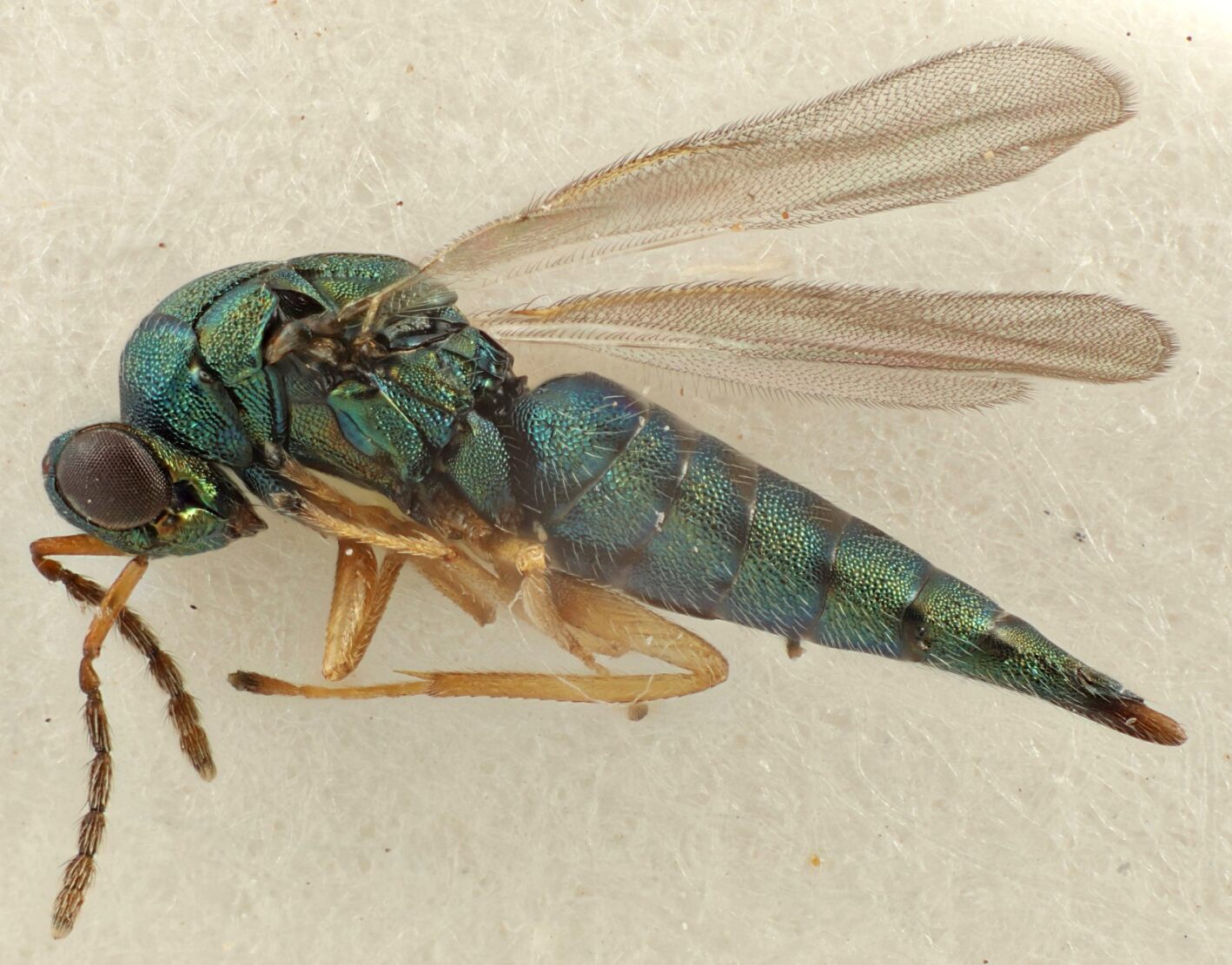Nearly every week in The Cipher this past year, I have written a Creature Drop about a species that is new to science. I choose many of these species because of their distinctiveness; if scientists discover an electric-blue tarantula or an unusually silent frog, I'm going to write about it. But this sampling of new species means I inevitably leave out many less charismatic species whose discovery invites little fanfare, despite the sheer number of them that are discovered each year. I am referring specifically to parasitic wasps.
Of the 815 new species described in 2023 by the Natural History Museum in London, 619 of them were wasps. By that count, I could have written about 12 new wasps each and every week in The Cipher. Of course, having the ability to do something does not mean one should do it and risk driving valued readers to unsubscribe en masse after the Wednesday edition becomes a hall of fame of 12 wasps, most of them parasitic. But a quick search through my archive of Creature Drops turned up absolutely zero wasps. Was I uninterested in the the wasps? Overwhelmed by their plenitude? Grossed out by the idea that some parasitic wasps parasitize other parasitic wasps like Matryoshka dolls infested with increasingly small wasp eggs? Perhaps all three.
I thought about an NPR segment from 2020 that suggested parasitic wasps may be the most diverse animals on Earth, even outnumbering beetles, which currently represent about a quarter of all known animal species. If there were even more parasitic wasp species than beetle species, I reasoned, surely the wasps would represent a significant chunk of the year's total new species. And I wondered, just how many parasitic wasps are discovered each year?
"This is a can of worms," Lynn Kimsey, an entomologist at the University of California, Davis, who studies bees and wasps, wrote in an email in response to my question. She does not know of any lists that record all new species of insects published each year. "Even though beetles are often touted as the most speciose, that’s just what’s been described," Kimsey said. Beetles are much larger, easier to collect, and often beautiful, leading to a profusion of professional and amateur researchers and collectors. But wasps are tiny, some as small as .2 mm, and thus must be caught in special mesh traps and nets, where researchers sift through material to see if there are any wasps. Some of the smallest groups of wasps have been ignored until recently due to how inconveniently tiny they are, according to John S. Noyes, a scientific associate at the Natural History Museum in London.
Beetles likely come in third place in terms of species diversity, falling after wasps and flies, according to Noyes and Christer Hansson, a colleague of Noyes at the museum and an associate at the Biological Museum at Lund University in Sweden. In the United Kingdom alone, scientists have described about 8,000 species of Hymenoptera, the order containing bees and wasps, 7,800 species of flies, and a measly 5,000 species of beetles. The case for the wasps is even more striking considering the number of beetle researchers hovers around 5,000, compared to about 15 or so dedicated wasp researchers, Noyes noted. "I think we would be in a golden age of discovery of new wasp species if we could increase the number of taxonomists," he said.
The dizzying number of wasp species relates to their penchant towards parasitism. Most wasps are parasitoids on other insects, with larvae living as parasites that eventually kill their insect host. "So for every beetle species there’s probably at least one or two parasitoid wasp species, one that attacks the eggs and one that attacks the larvae," Kimsey said.
Although Hansson and Noyes collectively published 574 new species of wasps in 2023, Hansson says 2009 was his banner year for new wasps, when he helped describe 355 new species, largely from one genus found in Costa Rica. "John and I both do stay on top of all described species in our respective group," Hansson said, referring to the parasitic wasp families Eulophidae and Encyrtidae, to ensure they do not describe existing species. "But, I do not keep tabs on other groups, I simply do not have the time or brain capacity for that."
Even if there were an exhaustive list of all the new insect species described each year, this list would still not tell the whole wasp story. "The number of new species described is more a metric of the number of taxonomists rather than any reality about insect diversity," Kimsey said, adding that the number of researchers who do taxonomy and describe new species is declining. "Discovering and describing new species are two different things, and the latter is not on the top of the list for funding in science," Hansson said. New DNA technology has made it fairly easy to detect different species in biological material, but the work of tracing that DNA to an actual species, described or undescribed, is laborious work. And the scientists who can put a species name on the DNA, Kimsey notes, are retiring and not being replaced. "Both John and I are retired and do not have any research funds for doing what we do, we pay for this privately," Hansson said.
Part of this lack of interest in wasps no doubt stems from the glancing coverage they receive in comparison to flashier insects and all vertebrates. As Noyes sees it, wasps get a bad reputation because we see them as pests that ruin picnics. But the smallest wasps can have outsized impacts on the world. In 1989, Noyes described the wasp Gyranusoidea tebygi, which has since become a crucial agent of biological control against the fruit-tree mealybug Rastrococcus invadens, which destroys mango and other fruit trees in Africa and Asia. And, of course, there would be no figs without parasitic wasps—a loss not just for newton-inclined dads, but also rainforests around the world. Figs are keystone plants in most tropical forests, and their loss would render the forests "completely different with fewer mammals and birds," Noyes said.
When I asked Noyes and Hansson if they had any favorite parasitic wasps, Noyes gave a teaser for a still-undescribed wasp. "The most beautiful of these is a species of Chrysoplatycerus that I shall be describing in the final volume" set to publish in 2029 or 2030, Noyes said, adding, "if I live that long." Hansson declined to pick a favorite. "To me they are all equally beautiful and interesting!" he wrote. He did attach a photo of a species he described from Mexico and Costa Rica in 2022, Closterocerus atrifasciatus. Does this wasp have any distinguishing qualities? "We do not know much about this species, apart from where and when it was found and what it looks like, but it is beautiful!" Hansson wrote.
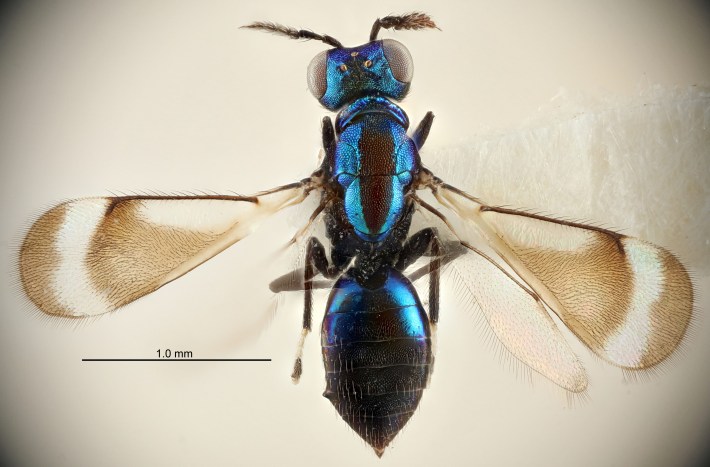
I realized this was one of the reasons I struggle with writing about new species of insects. Their species descriptions often lack context beyond their appearance and anatomy that can help me, and by extension readers, connect with the animal. This is of course not the fault of the wasps, which lead singular and fascinating lives, but rather the lack of funding for people to study these wasps, not just their taxonomy but also their lifestyle: who they parasitize, what might parasitize them, and other details of the extremely specific ecological niches they've carved out over millions of years.
So now, better late than never, it is my great honor to present to you a miniscule few of the very many new wasp species described this year. We may know very little about them, but we may consider that not a deterrent but a challenge! Who are they? How do they live? Gaze upon them and wonder.
Ooencyrtus pitosina
This parasitic wasp, found on the island of Tutuila in American Samoa, was first seen in 1885 but only described this past August. The wasp lays its eggs inside the eggs of the Samoan swallowtail butterfly, which is endangered. But the researchers suggest the wasp may help keep the butterfly's population stable, pruning out enough swallowtails to ensure the caterpillars do not strip the whole Samoan forest of its leaves.
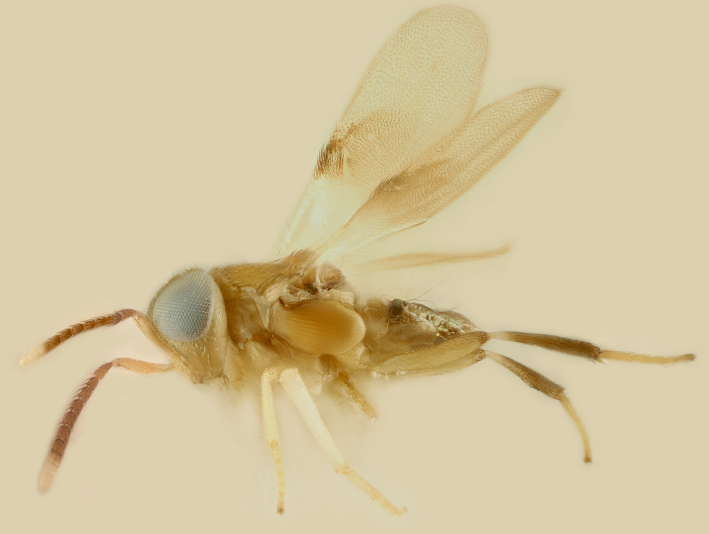
Capitojoppa amazonica
Headlines decried the new wasp Capitojoppa amazonica as "terrifying" and "horrifying." And in comparison to Ooencyrtus pitosina, it certainly looks more intimidating, especially to whatever unknown host it parasitizes. But as I am not a beetle or another wasp, I am not terrified by this wasp. I actually really like its antennae, which look like goat horns. Baa!
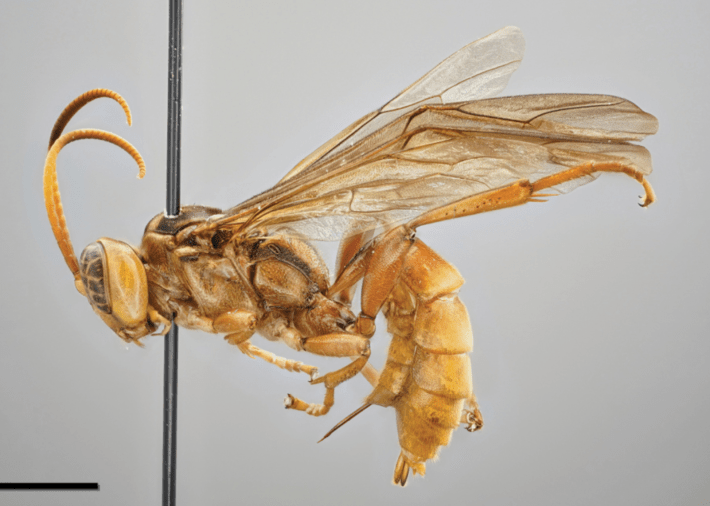
Podagritus apivorus
This wasp is by far the most mysterious of the list, as there are no public photos of its whole body. Podagritus apivorus lives in southwestern Australia and is active during the winter. The species was identified by Wojciech Pulawski, an entomologist emeritus at the California Academy of Sciences, and named for its habit of using bees as food for its larvae. Well, at least that's something! Hopefully there is more to come from this elusive wasp, which has every right to privacy on Mark Zuckerberg's internet.
16 New Loboscelidia Wasps, Wow!
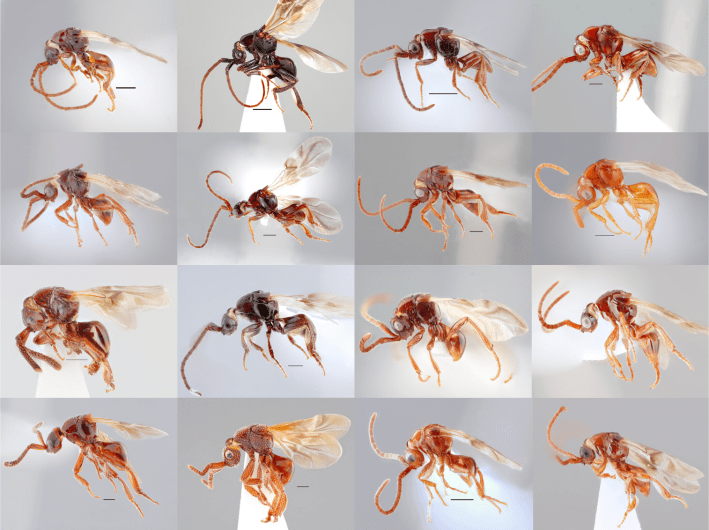
There are too many wasps here to name, but we can appreciate each wasp for its unique arrangement of general wasp-parts: wings, antennae, body hairs, etc. These wasps are all parasitoids belonging to the genus Loboscelidia, which is a group known to parasitize the eggs of stick insects. The researchers observed one female of one of the above wasp species laying her own egg inside a stick insect egg, and apparently she used her head to dig the hole inside which she would lay her own egg. Can you imagine that! Digging a hole with your head.
Galeopsomyia weinmannia
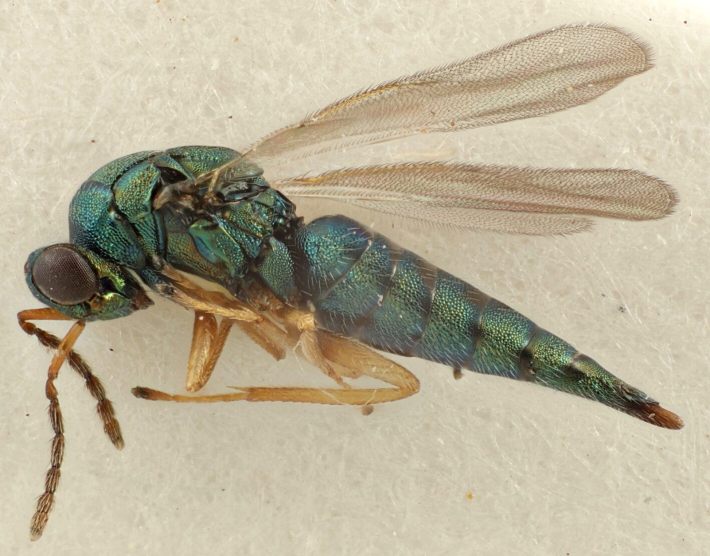
Let's round out this round-up with the simply beautiful Galeopsomyia weinmannia, which was described by Hansson from material in Costa Rica. The species was named after the host plant of the gall from which the scientists reared this wasp, who happens to be female. Do we know much else about this wasp? No. But a woman is entitled to her secrets.
